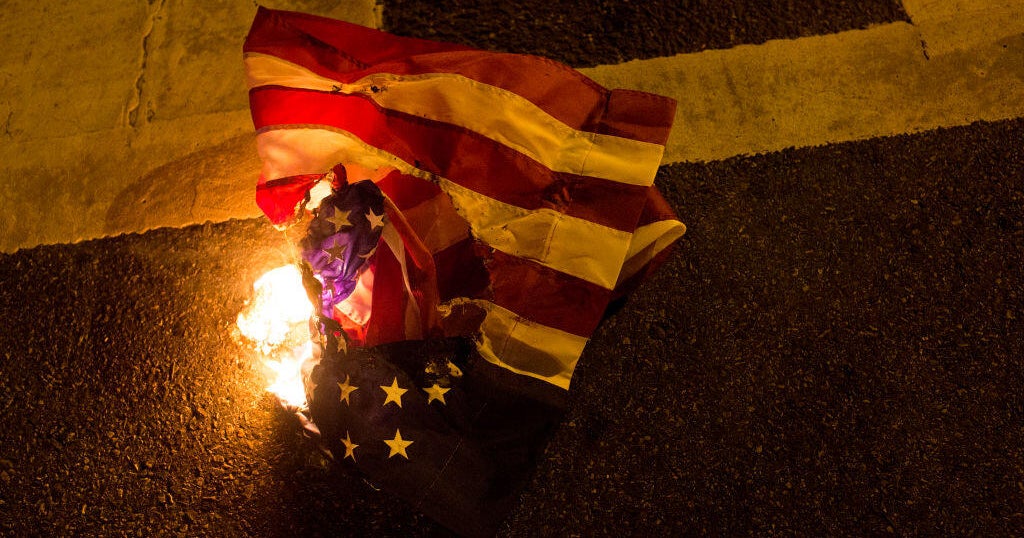President Donald Trump signed an executive order Monday tasking his secretary of defense, Pete Hegseth, with establishing “specialized units” in the National Guard that will be “specifically trained and equipped to deal with public order issues” — the clearest sign yet he intends to expand the US military’s role in domestic law enforcement activities across the country.
Under the newly signed order, Hegseth is charged with “ensuring that each State’s Army National Guard and Air National Guard are resourced, trained, organized, and available to assist Federal, State, and local law enforcement in quelling civil disturbances and ensuring the public safety and order whenever the circumstances necessitate, as appropriate under law.” A primary mission of the National Guard is already to be trained and available to assist law enforcement with public safety, often at the request of their state’s governor.
It also orders Hegseth to “designate an appropriate number of each State’s trained National Guard members to be reasonably available for rapid mobilization for such purposes” and establish a standing “quick reaction reaction force that shall be “available for rapid nationwide deployment.”
Questions remain, however, about how the order will work in practice. The National Guard already has reaction forces, designed to rapidly respond to incidents requiring law enforcement or security support in each state, territory, and the District of Columbia. These forces primarily perform their mission under the command and control of governors, and Trump’s executive order on Monday does not specify what authority the units outside of DC would report to if a state’s governor does not wish to use them.
“It seems very performative,” Rachel VanLandingham, a former Air Force judge advocate and current law professor at Southwestern Law School, told CNN on Monday. “It doesn’t seem to be telling the National Guard to do anything than it already does. But again, the devil is in the details of how they plan on using them.”
The executive order heightens existing concerns that the Trump administration is seeking to use the National Guard and federal law enforcement agencies for political purposes — particularly as the president appears to exclusively be considering deployments to cities run by Democrats in blue states.
This move follows a directive by Hegseth last week that authorized members of the National Guard deployed in Washington, DC, to begin carrying weapons.
National Guard members deployed to DC started carrying sidearms Sunday, a spokesperson for the Joint Task Force carrying out the mission told CNN. A release from Joint Task Force – DC on Sunday said Hegseth directed guard members to carry their assigned weapons. A US official told CNN on Monday that some troops will carry M4 rifles, as that is their primary weapon, whereas military police, for example, primarily use a M17 handgun. A Joint Task Force spokesperson said the troops are authorized to use their firearms for “personal protection” only, meaning self defense— and “not for policing.”
Hegseth’s order marked a notable shift in guidance from the Pentagon, which had previously indicated that National Guard members could be armed if the circumstances warranted.
The defense secretary told reporters in the Oval Office on Monday that the National Guard is “really proud to be a part of defending the nation’s capital and ensuring it is safe and beautiful, and working with law enforcement,” adding guard members deployed to the district “love this mission.”
On Monday, Trump suggested he’d ask Congress to codify the action expanding the National Guard’s remit, telling reporters in the Oval Office, “I think Democrats will actually vote for this.”
And he left the door open to deploying military to other cities, such as Chicago, telling reporters they are “ready to go anywhere,” with “less than 24 hours’ notice.” However, he suggested he’d wait until governors request National Guard troops before ordering deployments to address crime.
“We may wait, we may or may not — we may just go in and do it, which is probably what we should do,” Trump said. “The problem is, it’s not nice when you go in and do it and somebody else is standing there saying, as we give great results, say, ‘Well, we don’t want the military.’ They need help badly — Chicago desperately needs help. Just look at the crime statistics.”
Trump could send National Guard troops into a state against the governor’s wishes, reminiscent of what occurred in Los Angeles this summer, when troops were federalized. But that critical distinction of who the troops report to impacts what guard members can or cannot do while they are mobilized. Federalized troops, like those who mobilized in LA, cannot perform law enforcement activities, as it would be a violation of the Posse Comitatus Act. Troops on Title 32 orders, like those mobilized inside DC, are not subject to Posse Comitatus and therefore able to assist in law enforcement.
The DC National Guard is unique in that the president has the authority to activate them under Title 32, though that authority is typically delegated to the secretary of the Army. Otherwise, National Guard troops elsewhere in the country are under the control of their governors while on Title 32.
“DC sets a bad example,” VanLandingham said. “It sets an example of normalizing this when nothing is normal about it, and DC is not representative of other states. … It would just be a whole new world for them to try a Washington, DC-type maneuver in Chicago or anywhere else that’s not Washington, DC, because Washington, DC, is so legally different than any other area.”
“He wants to do DC in Chicago, but he doesn’t have the statutory authorities in DC unless he finally invokes the Insurrection Act,” she added. The Trump administration left the door open to invoking the Insurrection Act earlier this year in regard to military activity at the southern border, though the Pentagon and Department of Homeland Security did not recommend taking the dramatic step, which would allow Trump to use active-duty military forces within the US to perform law enforcement.
Sen. Tammy Duckworth, a Democrat from Illinois, forcefully objected Sunday to the possibility of Trump deploying the National Guard to Chicago — something the president has said he is strongly considering.
“It comes as no surprise Donald Trump is once again attacking Chicago, but that doesn’t change that Trump’s continuing pattern of politicizing and misusing our nation’s military for his own partisan gain and to crush dissent is deeply disturbing, is un-American and has no place in any of our cities,” Duckworth, a combat veteran and member of the Senate Armed Services, said in a statement ahead of Monday’s executive order signing.
Logistically, Monday’s executive order also leaves questions unanswered as to how the “specialized units” would train or whether there would be coordination between those units across the states.
“Are you saying each state is going to have its own quick reaction force that can handle everything? Are you looking at an amalgamation of units that come together under a Pentagon official, commander? If so, then you need to have a schoolhouse where they’re getting together and training on this, and what are the regulations on it? … This is classically how military missions fail, when you don’t have clear guidance and you haven’t been training together,” VanLandingham said.
National Guard troops on the DC mission are expected this week to begin assisting more with the “beautification” piece of the mission. A US official told CNN on Monday that the guard is working through what equipment will be needed and what sites they’ll assist with, but tasks are expected to include things like painting over graffiti, picking up trash, and removing driftwood from the Tidal Basin by the Martin Luther King Jr. memorial.
The executive order signed in March titled, “Making the District of Columbia Safe and Beautiful,” directed a “coordinated beautification plan” for facilities, monuments and parks in DC, the removal of graffiti, and to “ensure the cleanliness of public spaces.”
For weeks, Trump has ramped up efforts to crack down on crime in Washington, DC, which has also included a federal takeover of the city’s police department and increased federal law enforcement presence. The president has repeatedly complained about rising crime in DC, but overall crime numbers are lower this year than in 2024.
To assist the DC National Guard, troops from the National Guards in West Virginia, South Carolina, Mississippi, Ohio, Louisiana and Tennessee were called upon. Troops from the GOP-led states began arriving in the nation’s capital last week. As of Sunday morning, there were 2,274 National Guardsmen on the mission, more than 1,300 of them from supporting states.
In the week beginning August 12, the first full day the Trump administration had control of the Metropolitan Police Department, the city saw a moderate drop in reported crime — and a far larger surge in arrests of immigrants, a CNN analysis of government data found.
CNN’s Brian Todd contributed reporting.

